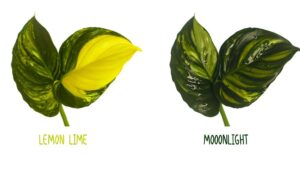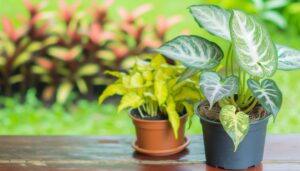Philodendron Lupinum Vs Micans: A Comprehensive Guide!
Philodendron Lupinum and Philodendron Micans, originating from tropical rainforests of Central and South America, exhibit distinct botanical characteristics. Philodendron Lupinum features smooth, glossy, heart-shaped leaves that shift from vibrant green to dark green as they mature.
In contrast, Philodendron Micans has velvety-textured leaves that transform from bronze-toned to deep green. Lupinum exhibits robust climbing behavior with aerial roots, while Micans tends towards cascading growth.
Both species thrive in bright, indirect light, high humidity, and well-aerated, nutrient-rich soils. Consistent temperatures and appropriate watering are essential for optimal growth.
Explore further to discover detailed care requirements and growth dynamics.
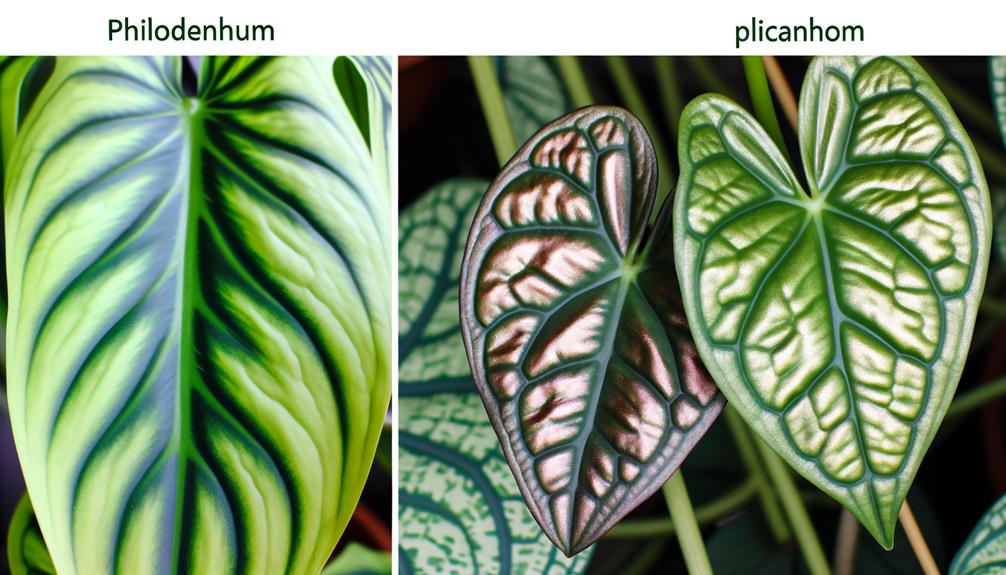
Key Takeaways
- Philodendron Lupinum has smooth, glossy leaves, while Micans has a velvety texture.
- Lupinum displays robust climbing behavior; Micans has a restrained vining growth suitable for cascading.
- Micans leaves transition from bronze to deep green; Lupinum leaves change from vibrant green to darker green.
- Both species thrive in bright, indirect light and require well-aerated, nutrient-rich soil.
- Ideal humidity for both plants is 60%-80%, with optimal temperatures between 65°F to 80°F.
Characteristic of Philodendron Lupinum vs Micans
| Characteristic | Philodendron Lupinum | Philodendron Micans |
|---|---|---|
| Leaf Shape & Texture | Small, heart-shaped leaves with a smooth, glossy texture. | Velvet-textured, heart-shaped leaves with a soft sheen. |
| Leaf Color | Bright green leaves with a slight shimmer. | Dark green with bronze or purple undertones. |
| Growth Habit | Compact and climbing, requires support as it grows. | Trailing or climbing vine, ideal for hanging baskets or trellises. |
| Size | Stays relatively small, up to 2-3 feet indoors. | Can grow longer as a trailing plant, up to 6 feet or more. |
| Light Requirements | Prefers bright, indirect light, but tolerates lower light. | Thrives in low to medium indirect light. |
| Care Difficulty | Low-maintenance, ideal for beginners. | Easy to care for, great for beginners and indoor spaces. |
| Native Region | Native to tropical rainforests in Central and South America. | Native to Central America and the Caribbean, common as a houseplant. |
Origin and Background
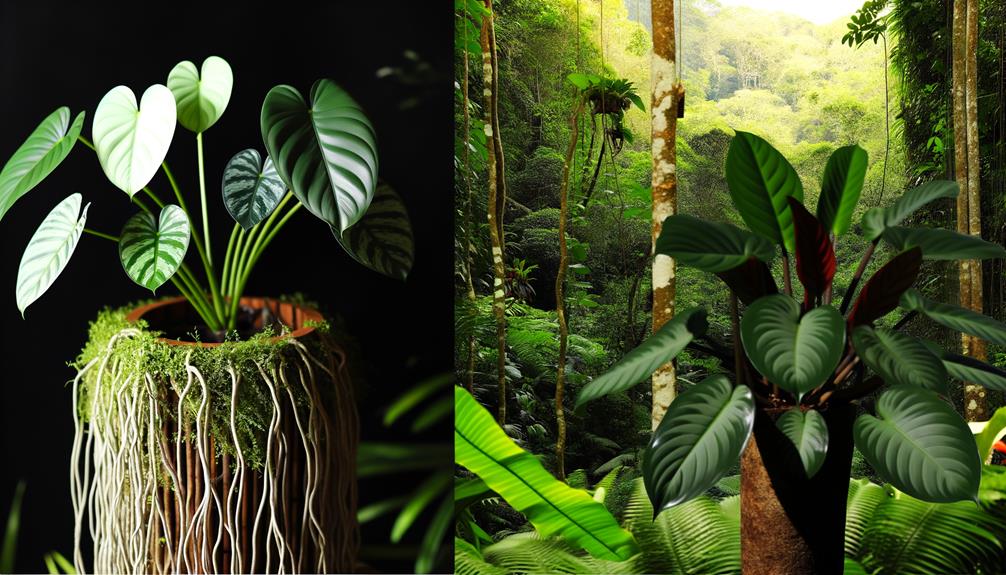
Both Philodendron Lupinum and Philodendron Micans originate from the tropical rainforests of Central and South America, where they thrive in the understory layer. This ecological niche is characterized by low light levels, high humidity, and a stable, warm climate, conditions which these species have adapted to over millennia.
Philodendron species are integral components of their native habitats, playing pivotal roles in the ecosystem by providing foliage cover and contributing to the forest’s complex vertical structure. The genus Philodendron, belonging to the Araceae family, exhibits remarkable diversity and adaptability.
Philodendron Lupinum is typically found in the dense forest floors of Brazil, while Philodendron Micans is spread more broadly across regions including Mexico and the Caribbean. Their natural habitats influence their care requirements in cultivation.
Leaf Shape and Texture
Philodendron Lupinum and Micans both exhibit a heart-shaped leaf morphology, a common trait within the Araceae family.
The primary distinction lies in the textural characteristics; Philodendron Lupinum leaves display a smooth, slightly glossy surface, while Philodendron Micans are noted for their pronounced velvety texture.
These differences not only influence the visual appeal but also affect light reflection and tactile experience.
Heart-Shaped Leaf Structure
Characterized by their heart-shaped leaves, Philodendron Lupinum and Micans exhibit distinct variations in leaf shape and texture that are essential for accurate identification and differentiation between the species. Philodendron Lupinum’s leaves are more elongated with pronounced lobes at the base, lending an arrowhead-like appearance. In contrast, Philodendron Micans features broader, more ovate leaves with a more rounded base, contributing to a fuller heart shape. Additionally, the texture of Lupinum’s leaves tends to be more rigid and slightly corrugated, compared to the softer, more pliable texture of Micans’ leaves. These morphological differences are vital for botanists and plant enthusiasts alike.
| Aspect | Philodendron Lupinum | Philodendron Micans |
|---|---|---|
| Leaf Shape | Elongated, arrowhead-like | Ovate, fuller heart-shaped |
| Base Lobes | Pronounced | Rounded |
| Leaf Texture | Rigid, slightly corrugated | Soft, pliable |
These characteristics provide a reliable means of distinguishing between these two species.
Velvety Surface Differences
In addition to their distinctive heart-shaped leaf structures, the velvety surface differences between Philodendron Lupinum and Philodendron Micans offer further morphological insights that aid in species identification.
Philodendron Lupinum leaves exhibit a more pronounced velutinous texture, characterized by densely packed trichomes that impart a rich, tactile softness. The surface appears almost suede-like, enhancing the leaf’s luxurious feel.
In contrast, Philodendron Micans possesses a subtler velvet texture, with fewer trichomes resulting in a smoother, less plush surface. The Micans’ leaves often exhibit a slight iridescence, shifting in hue under varying light conditions.
These textural distinctions are not merely aesthetic but also functional, influencing factors such as moisture retention and light absorption, critical for their respective microhabitats.
Color Variations
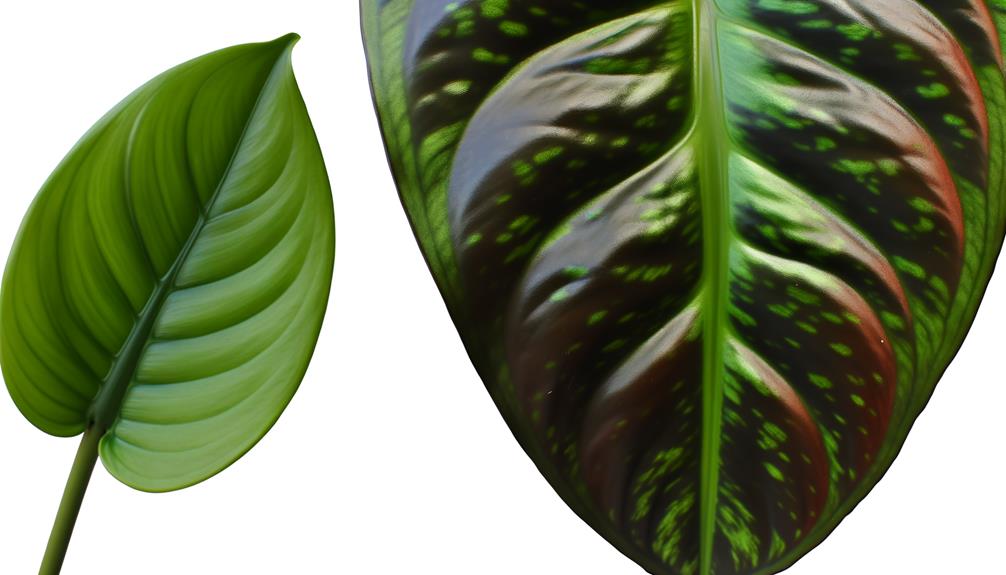
Color variations between Philodendron Lupinum and Philodendron Micans are striking, particularly when considering leaf hue and maturation changes.
Philodendron Lupinum shows a noticeable change from vibrant green young leaves to darker, more glossy green as it matures, while Philodendron Micans has soft, bronze-toned young leaves that shift to a deep, vibrant green.
These color changes are not only visually unique but also reflect their distinct physiological and developmental processes.
Leaf Color Differences
Leaf color variations between Philodendron lupinum and Philodendron micans are primarily distinguished by the subtle interplay of pigment concentrations and surface texture. Philodendron lupinum features a deep green hue with a velvety texture, resulting from high chlorophyll content and dense trichomes. Conversely, Philodendron micans exhibits a bronze-green coloration with an iridescent sheen, attributed to anthocyanin pigments and a smoother leaf surface. These pigment and texture differences yield distinct aesthetic qualities, essential for botanical identification and horticultural appreciation.
| Attribute | Philodendron lupinum | Philodendron micans |
|---|---|---|
| Primary Color | Deep Green | Bronze-Green |
| Texture | Velvety | Smooth |
| Pigment Type | High Chlorophyll | Anthocyanin |
| Additional Note | Dense Trichomes | Iridescent Sheen |
Understanding these variations enhances our appreciation and selection of these philodendrons for specific horticultural applications.
Maturation Color Changes
While the distinct leaf color differences between Philodendron lupinum and Philodendron micans are notable, their maturation color changes further elucidate the dynamic nature of these species.
Philodendron lupinum exhibits a shift from a vivid green in juvenile foliage to a darker, more subdued green with pronounced venation as it matures.
In contrast, Philodendron micans undergoes a transformation from a bronze or coppery hue in its nascent stage to a rich, velvety green as it ages, often accompanied by a subtle iridescent sheen.
These color shifts are indicative of the adaptive physiological processes inherent to each species, reflecting their unique pigmentation pathways and metabolic adjustments in response to their environment.
Understanding these changes is pivotal for ideal cultivation and appreciation.
Growth Patterns
In understanding the growth patterns of Philodendron lupinum and Micans, it is essential to examine their respective vining habits and environmental adaptability.
Philodendron lupinum exhibits robust climbing behavior, characterized by elongated internodes and vigorous aerial root development, enabling effective anchoring to vertical supports.
In contrast, Philodendron micans demonstrates a more restrained vining tendency with shorter internodes and less pronounced aerial root formation, making it suitable for cascading growth in hanging planters.
Both species display remarkable adaptability to varied humidity levels and temperature ranges, though ideal growth occurs in consistently warm, humid environments.
Differences in growth vigor and structural morphology highlight each species’ unique ecological niches and cultivation requirements, informing their care and maintenance in horticultural practices.
Light Requirements
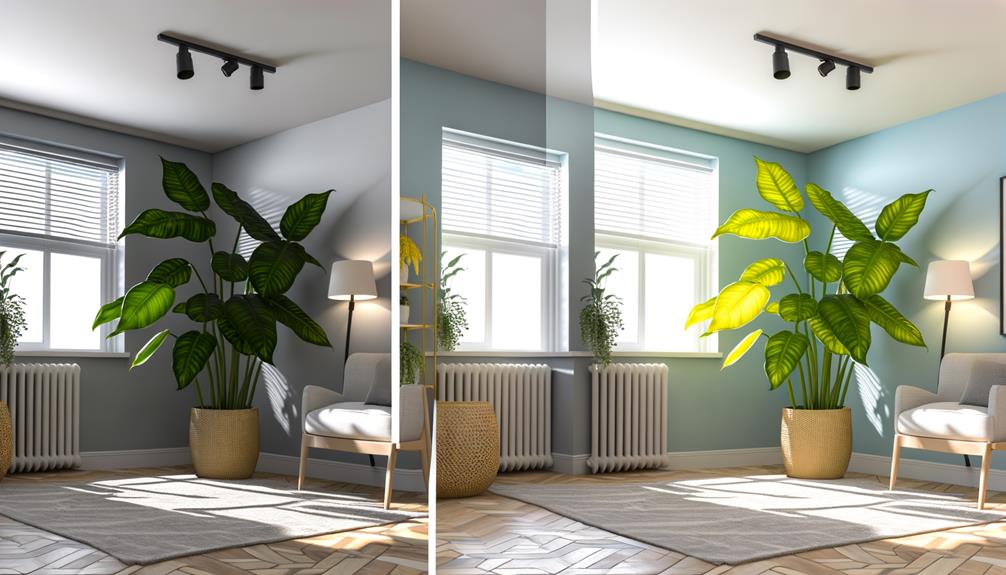
Understanding the light requirements for Philodendron lupinum and Micans is crucial in enhancing their distinct growth patterns and ensuring robust plant health.
Both species thrive in environments with bright, indirect light, as direct sunlight can cause leaf scorching and photodamage. Philodendron lupinum prefers slightly higher light levels, promoting more vigorous growth and vivid leaf coloration.
Conversely, Micans exhibits greater tolerance for lower light conditions, though optimal growth is achieved under moderate indirect light. Utilizing light meters can aid in maintaining appropriate light intensity, typically ranging between 10,000 to 20,000 lux.
Artificial lighting, such as full-spectrum LED grow lights, may be employed to supplement natural light, particularly in regions with limited sunlight exposure. Proper light management directly correlates with healthy foliage and overall plant wellness.
Watering Needs
Proper watering is essential to the health of Philodendron lupinum and Micans, requiring a well-calibrated balance to prevent root rot and dehydration.
Both species thrive under conditions where the substrate remains consistently moist but not waterlogged. It is important to allow the top inch of the growing medium to dry out between waterings.
Overwatering can lead to hypoxic conditions in the root zone, promoting pathogenic fungi responsible for root rot. Conversely, prolonged drought stress can result in foliar chlorosis and abscission.
Environmental factors, such as ambient humidity and temperature, should guide the watering frequency. Employing a moisture meter can enhance precision, ensuring optimal hydration levels for these aroids.
Monitoring plant responses is vital for adjusting watering practices accordingly.
Soil Preferences
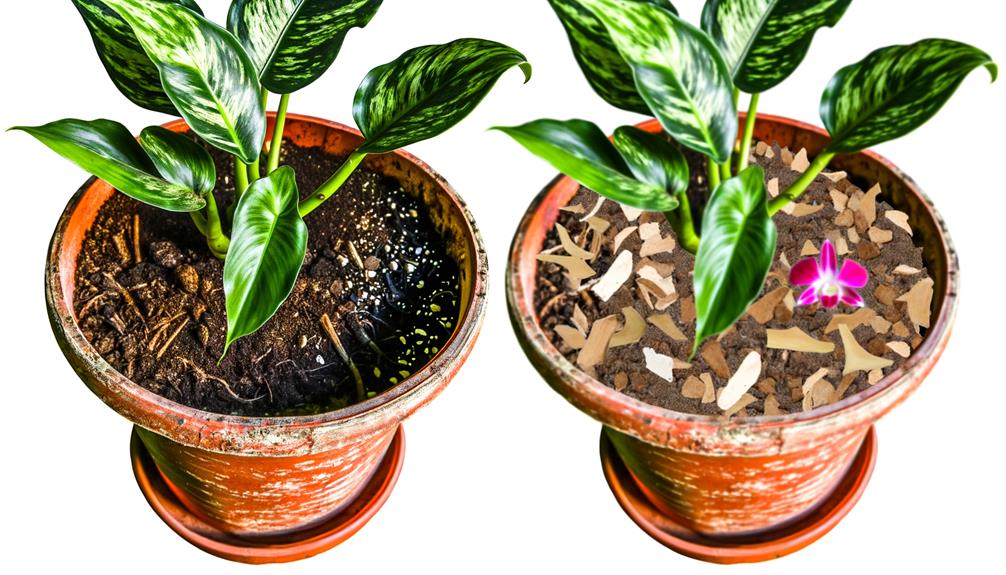
Choosing the right soil mix is crucial for the best growth of Philodendron lupinum and Micans, necessitating a well-aerated, nutrient-rich substrate that promotes strong root development and avoids waterlogging. Best soil composition should include a blend of organic matter, such as peat moss or coconut coir, and inorganic materials like perlite or orchid bark, to ensure sufficient drainage and aeration.
Below is a comparative table outlining the preferred soil components:
| Component | Function |
|---|---|
| Peat Moss | Retains moisture while providing aeration |
| Perlite | Improves drainage and prevents compaction |
| Orchid Bark | Encourages root aeration |
| Coconut Coir | Eco-friendly moisture retention |
| Compost | Provides essential nutrients |
Utilizing these components will create an optimal growing medium for both species.
Humidity Levels
Maintaining adequate moisture levels is crucial for the best growth and health of Philodendron lupinum and Micans, as these species thrive in environments with high moisture levels in the air. Ideal relative humidity ranges between 60% and 80% for both species.
Inadequate humidity can result in drying out of leaf margins and potential stomatal closure, affecting photosynthetic efficiency. Implementing humidity-boosting strategies, such as misting, using humidifiers, or placing plants on humidity trays, can effectively mitigate less than ideal conditions.
Regular monitoring with a hygrometer ensures accurate management of ambient humidity. Moreover, grouping plants can create microenvironments favorable for higher humidity levels. Consistent maintenance of these conditions promotes vigorous vegetative growth and reduces abiotic stress factors.
Temperature Tolerance

Philodendron lupinum and Micans display excellent growth at temperatures ranging from 65°F to 80°F (18°C to 27°C), reflecting their native tropical habitats. These species show a preference for consistently warm conditions, avoiding exposure to temperatures below 55°F (13°C), which can induce stress and inhibit physiological processes.
Sudden temperature fluctuations are harmful, potentially leading to cellular damage and compromised growth. Conversely, temperatures exceeding 85°F (29°C) may accelerate transpiration rates, necessitating increased humidity to prevent desiccation. Monitoring ambient temperatures is essential, as prolonged exposure to suboptimal conditions can lead to chlorosis, reduced vigor, and increased susceptibility to pathogens.
Thus, maintaining a stable thermal environment is crucial for the excellent health and development of Philodendron lupinum and Micans.
Pruning and Maintenance
Pruning and maintenance of Philodendron lupinum and Micans involve strategic removal of dead or damaged leaves to promote ideal light penetration and air circulation, enhancing overall plant health and vigor. Employing sterilized pruning shears prevents pathogen transmission, ensuring the cut sites heal without infection.
For Philodendron lupinum, trim back leggy growth to maintain a compact structure, while Micans benefit from periodic pinching of new growth to encourage bushier foliage. Regularly inspect both species for senescent leaves and prune as necessary.
Proper maintenance also involves wiping leaves with a damp cloth to remove dust, optimizing photosynthetic efficiency. These practices, executed with precision, contribute to robust, aesthetically pleasing specimens.
Common Pests
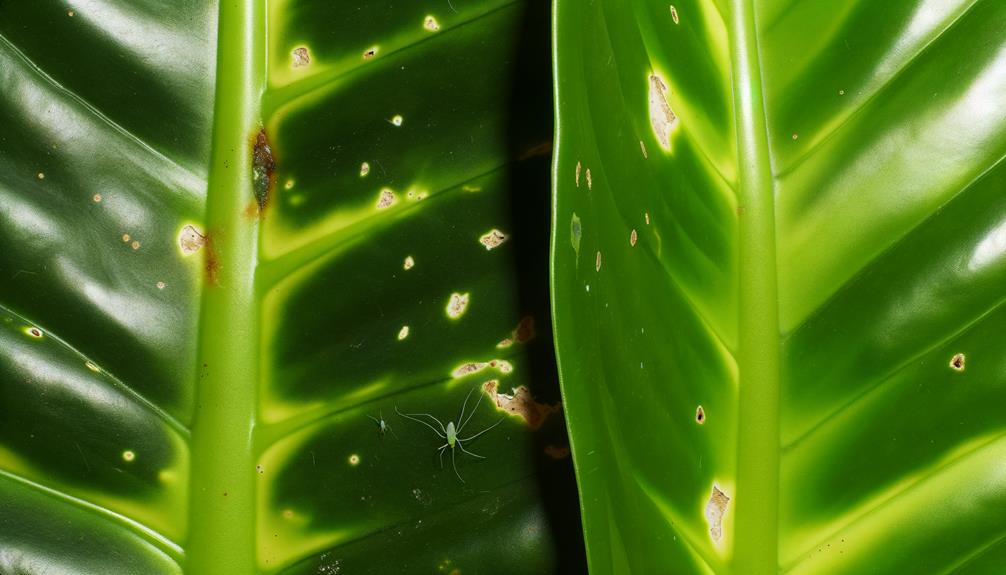
In addition to proper pruning and maintenance, vigilant monitoring for common pests such as spider mites, aphids, and mealybugs is essential to guarantee the health and longevity of Philodendron lupinum and Micans.
Spider mites (Tetranychidae) are minuscule arachnids that cause stippling on leaves, leading to chlorosis. Aphids (Aphidoidea), small sap-sucking insects, can induce leaf deformations and transmit plant viruses. Mealybugs (Pseudococcidae), recognizable by their white, cotton-like excretions, can stunt plant growth and cause leaf drop.
Regular inspections, particularly on the underside of leaves and at stem junctions, are necessary. Implementing biological controls, such as predatory insects, and utilizing horticultural oils or insecticidal soaps can effectively mitigate infestations, ensuring the robust growth of these Philodendron species.
Propagation Methods
Successfully propagating Philodendron lupinum and Micans involves employing techniques such as stem cuttings, air layering, and division, each requiring specific conditions to promote growth and development.
Stem cuttings, the most common method, necessitate selecting a healthy node, making sure at least one leaf and aerial root is present, and placing the cutting in water or a well-draining medium.
Air layering entails wounding a stem section, wrapping it with moist sphagnum moss, and encasing it in plastic to maintain humidity until roots form.
Division, less frequently used, involves separating rooted sections from the mother plant.
Each method demands ideal environmental conditions, including temperature, humidity, and light, to ensure successful root initiation and plant establishment.
Conclusion
To sum up, Philodendron lupinum and Philodendron micans, each showcasing their unique leaf shapes and colors, offer a lush display of plant diversity.
The elongated, velvety leaves of lupinum stand out in comparison to the heart-shaped, shimmering foliage of micans, forming a diverse blend of textures and colors.
Both plants display distinct growth habits and adaptability to their surroundings, needing precise light and temperature settings.
Recognizing these subtleties helps in nurturing and propagating these plant varieties, ensuring their successful growth in their specific habitats.

